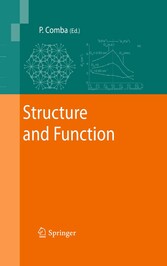Suchen und Finden
Structure and Function
1
Jan C.A. Boeyens – A Holistic Scientist
4
Root
8
Preface
10
Contents
12
Contributors
14
1 Molecular Associations Determined from Free Energy Calculations
16
1.1 Introduction
16
1.2 Statistical Mechanics of Molecular Association
18
1.3 Condensed Phase Molecular Dynamics Simulations
20
1.4 Free Energies from Adaptive Reaction Coordinate Forces
20
1.5 Associative Solvents
22
1.5.1 Water
23
1.5.2 Methanol
25
1.6 Ions in Associative Solvents
29
1.7 Reactions in Associative Solvents
32
References
34
2 Molecular Modelling for Systems Containing Transition Metal Centres
36
2.1 Introduction
36
2.2 Molecular Mechanics
39
2.2.1 Shortcomings of MM for TM Systems
41
2.2.2 Ligand Field Molecular Mechanics
42
2.3 Applications of LFMM
44
2.3.1 Simple Coordination Complexes: Cu(II) Amines
45
2.3.2 [MCl4]2- Complexes
46
2.3.3 Cu(II) Bis-oxazoline Complexes
48
2.3.4 Jahn–Teller Effects in Six-Coordinate Cu(II) Complexes
49
2.3.4.1 The Mexican Hat Potential Energy Surface
49
2.3.4.2 The Warped Mexican Hat
50
2.3.4.3 Theoretical Treatment of the Jahn–Teller Effect in Cu(II) Species
52
2.3.4.4 Barriers Between Successive Elongations
54
2.3.4.5 Truly Compressed Complexes
56
2.3.5 Spin-State Effects
56
2.3.6 Type 1 Copper Enzymes
57
2.3.7 Dinuclear Copper Centres
60
2.4 Conclusions
64
References
65
3 Magnetic Anisotropy in Cyanide Complexes of First Row Transition Metal Ions
67
3.1 Introduction
67
3.2 Jahn–Teller Coupling Versus Spin-Orbit Coupling in the Ground State of [Fe(CN)6]3-
69
3.3 Modeling of the Magnetic Anisotropy in Ni-NC-FeIII Pairs
77
3.3.1 Theory
77
3.3.2 Regular (C4v) Versus Distorted (Cs) [Fe(CN)63-] and Its Influence on the Magnetic Anisotropy of the Fe-Ni Pair
79
3.3.3 Effect of Combined Spin-Orbit Coupling and Strain at the FeIII Subunit
82
3.4 Magnetic Anisotropy in Linear Trinuclear Cu-NC-Fe-CN-Cu complexes
85
3.5 Computation of the Magnetic Anisotropy in Oligonuclear Complexes with Nearly Degenerate Ground States
88
3.5.1 Theory
88
3.5.2 Applications to Various Cyanide-Bridged MnFem Complexes (M = CuII, NiIII)
93
3.6 Conclusions
96
References
97
4 Structure and Function: Insights into Bioinorganic Systems from Molecular Mechanics Calculations
100
4.1 Introduction
100
4.2 The MM Method
101
4.3 Handling Metal Ions
102
4.4 Extending the Force Field
103
4.5 Applications of the Corrin Force Field: Structure and Function of B12 Derivatives
106
4.6 Applications of the Corrin Force Field: The Structure of the Cobalt Corrins in Solution
107
4.7 Applications of the Porphyrin Force Field: The Solution Structures of the Complexes Formed Between Ferriprotoporphyrin IX and Arylmethanol Antimalarials
109
References
118
5 Artificial Photosynthetic Reaction Center
123
5.1 Introduction
123
5.2 Electron Donor–Acceptor Ensembles with Covalent Bonding
125
5.2.1 Multi-step Electron Transfer
125
5.2.2 Nanocarbon Materials Linked with Multiple Porphyrins
128
5.2.3 Simple Electron Donor–Acceptor Dyads with Long CS Lifetimes
130
5.3 Electron Donor–Acceptor Ensembles with Non-covalent Bonding
133
5.3.1 – Interaction
133
5.3.2 Porphyrin Nanochannels
136
5.3.3 Supramolecular Electron Donor–Acceptor Complexes of Phthalocyanines
139
5.4 Summary
142
References
142
6 Multifrequency EPR Spectroscopy: A Toolkitfor the Characterization of Mono- and Di-nuclear MetalIon Centers in Complex Biological Systems
145
6.1 Introduction
145
6.2 Multifrequency EPR Toolkit
146
6.2.1 g-Value Resolution and Orientation Selection
148
6.2.2 Magnitude of the Microwave Frequency
150
6.2.3 State Mixing
150
6.2.4 Angular Anomalies
150
6.2.5 Distribution of Spin Hamiltonian Parameters
151
6.2.6 Numerical Differentiation and Fourier Filtering
153
6.2.7 High Resolution EPR Techniques
154
6.2.8 Geometric and Electronic Structure Determination
154
6.2.8.1 Computer Simulation
155
6.2.8.2 Computational Chemistry
156
6.2.8.3 Molecular Sophe – An Integrated Approach
157
6.3 Application of Multifrequency EPR to the Structural Characterization of Complex Biological Systems
161
6.3.1 EPR Studies of MoV Complexes and Their Relevance to Mononuclear Molybdenum Enzymes
161
6.3.2 EPR Studies of Copper(II) Cyclic Peptide Complexes
168
6.3.2.1 Copper(II) Complexes with Marine Cyclic Peptides
168
6.3.2.2 Copper(II) Complexes with Westiellamide and Synthetic Analogues
172
6.3.3 Purple Acid Phosphatases
176
6.4 Conclusions
183
References
183
7 On Stacking
188
7.1 Introduction
188
7.2 Intra- and Inter-Strand Base Stacking
190
7.3 Parallel and Perpendicular Intercalating Agents
191
7.3.1 Cofacial Versus Edge-On Stacking
193
7.4 Base-Backbone Inclination and Sugar-Base Stacking
194
7.4.1 Amino Acid-Nucleobase Stacking
196
7.5 Stacked Dipoles: The C-Rich i-Motif
197
7.6 Cation– Interactions
199
7.7 Lone Pair– and Anion– Interactions
200
7.8 Unique Properties of the TATA-Motif Major Groove
202
7.9 Conclusion
204
References
204
8 Structurally Complex Intermetallic Thermoelectrics – Examples from Modulated Rock-Salt structuresand the System Zn-Sb
208
8.1 Introduction
208
8.1.1 Incommensurate Structure Analysis
210
8.1.2 Modulated Rock-Salt Like Compounds
212
8.1.3 The Remarkable System Sb-Zn
217
8.2 Conclusion
226
References
227
9 Solid State Transformations in Crystalline Salts
229
9.1 Introduction
229
9.2 Solid State Transformation in Some Metal-Organic Salts
230
9.3 Sublimation and Dissociation in Simple Salts of an Organic Compound
234
9.3.1 Crystal Structures and Isostructurality
234
9.3.2 Thermal Analysis
235
9.3.3 Comparison of 3H+.Cl- and 3H+.NO3-
240
References
242
10 Influence of Size and Shape on Inclusion Propertiesof Transition Metal-Based Wheel-and-Axle Diols
244
10.1 Shape and Packing
244
10.2 Metallo-organic Frameworks: Transition Metal-Based Wheel-and-Axle Diols
246
10.2.1 Structural Analysis of Trans-palladium(II) Complexes of Triarylcarbinol Ligands: A Class of Transition Metal-Based Wheel-and-Axle Diol
249
10.2.1.1 Identification of the ``Bistable Framework'
249
10.2.1.2 Inclusion Sites and Guest Migration
251
10.2.2 Robustness of the Pattern with Increasing Shape Complexity
253
10.2.3 Validation of the Wheel-and-Axle Shape
259
References
261
Index
263
Alle Preise verstehen sich inklusive der gesetzlichen MwSt.








